Interview with Matti Alahuhta, CEO KONE Corporation
“The continuity coming from the family ownership history is an asset for us in developing a strong performance culture.”
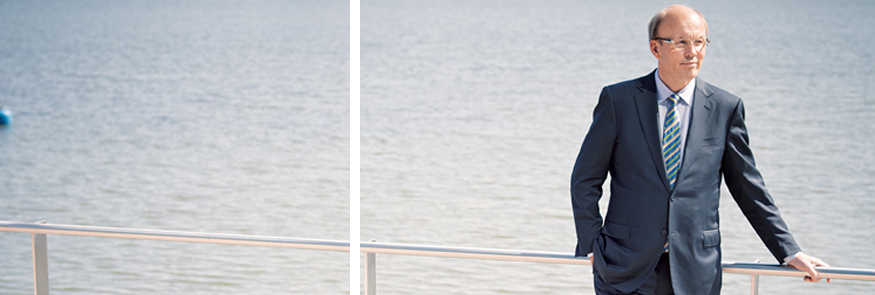
Controlled by the Herlin family since 1924, escalator and elevator manufacturer KONE Corporation celebrated its centenary in 2010. Under the leadership of non-family President and CEO Matti Alahuhta, KONE has consistently hit or exceeded its targets. Talking to THE FOCUS, Alahuhta explains how the company’s origins as a family firm have helped forge an outstanding performance culture.
The Focus: You joined KONE as President in 2005 before becoming President and CEO in 2006. What were your first impressions coming toKONE? Did you find there were immediate challenges to deal with or were you able to focus on developing a longer-term framework for change?
Matti Alahuhta: Naturally my first challenge was to acquire an in-depth understanding of the company as quickly as I could in order to establish a basis for change. One key point, however, is that KONE was doing rather well as a company. It had a strong history and had developed successfully over the years.
The change process started in February of 2005 when we gathered about 30 key people from different parts of the world, a very diverse group that also included some young talent. For one week we worked together from early morning to late at night to build a better understanding of where we were and where we wanted to be. We decided to raise our ambition level and defined the desired target position for the years to come.
During that week, we formulated our new strategy and what our five key development programs would be. Internally, we call them “must-win battles”. And we assigned owners to them.
In my first year at KONE, I travelled extensively to different parts of the world to talk about the need for change. From the very beginning of the change process we set out to develop a holistic view – a context for change that we could communicate to our people to really give them an understanding of how we wanted to put things together to take the company’s competitiveness on to the next level. We wanted every KONEperson to understand what these critical changes would mean to their work, and how their work was connected to the objectives we wanted to achieve. We presented our program starting with the key megatrends impacting on our industry, and the fact that our industry is actually in a fortunate position with regard to long-term growth opportunities.
The Focus: Do you see the company’s culture and its family-owned roots as a factor in this holistic approach?
Alahuhta: Yes, in the sense that KONE’s company culture and history made it easier to communicate our message. Everyone in the company knows who the chairman is, and that he’s a member of the Herlin family, which has been the key owner for almost a hundred years. The chairman’s mindset is very much long term, and his presence stands for consistency and continuity of values. It’s difficult to quantify everything this brings to the company, but these elements gave us a definite strength in imparting a clear sense of mission and motivating people with regard to our change program.
One of our guiding principles has been to manage the change process so that people can be proud of their company history. From the start we have relied heavily on the people who had been with the company the longest and developed these people to give them a sense of involvement and ownership. We rotated many of them into new positions to further our program, while simultaneously starting to recruit some new talent. In this way, we took the strength from the past to build new strength.
“The chairman’s mindset is very much long term, and his presence stands for consistency and continuity of values.”
The Focus: You pointed out that the company was doing quite well when you arrived. How did you create a sense of urgency for a change program when people were quite satisfied to begin with?
Alahuhta: In 2004 our operating income level was 8 percent. That is not great, but it is quite good. However, global competition was developing in such a way that we needed to start generating more growth. And we also saw clear opportunities to start improving our operating margins.
Of course it is more difficult to initiate a change process when a company is doing rather well than when it is in a period of crisis. The way we handled this was quite simple, and again, tied to the bigger picture. We drew a couple of graphs that showed that the current growth rate was not enough, and what would happen if we didn’t start to grow faster. A second set of graphs addressed productivity as compared to our key competitor, and showed what would happen in the longer term if productivity did not improve. This made it easy for people to understand the need for change.
Then we set out the key directions for change. First of all, we had to become more customer-focused. Secondly, we had to become more global in terms of defining best practices and a clear holistic process architecture, that is to say, developing and implementing unified, common processes around the world. Thirdly, we were in the same situation that most European companies were in and still are, where product competitiveness is stronger in Europe than on the other continents. So in terms of product and service development we had to shift priority to the Asia-Pacific region especially, but also to the Americas. In addition, we wanted to speed up our decision-making in everything we do, and really start to generate profitable growth. These were our key directions for change.
The Focus: You said that KONE and the industry were well positioned to address growth and productivity concerns with regard to the key megatrends you identified.
Alahuhta: Yes. By megatrends I mean increasing urbanization, an aging population, and environmental requirements – mainly as they impact on urbanization. For our industry, urbanization – the movement of people from rural to urban areas – is the most important of these. It is estimated that during the next 20 years, the global urban population will grow from 3.4 billion to close to 5 billion people. Much of that growth will be in the larger, developing countries, such as China, where during the last 15 years the urban population has grown by 350 million people. And in India, where urbanization is also speeding up.
Basically, the concentration of people in urban areas highlights the importance of the smooth movement of people in the same space at the same time – and the need to do that in an eco-efficient way. We will be seeing more and more high-rise buildings, and not only in developing countries.
At the beginning of 2008, we introduced our vision shaped around this megatrend in a positioning statement: “KONE delivers the best people flow experience.” Once we had defined our vision, we set out to communicate it to all our people, so that we could all start to see our company through the eyes of customers and users. This vision also brings clarity to our business scope. Our strategy consists of two elements: differentiation by developing the best user and customer experience; and continuously strengthening our competitiveness by developing our people and processes.
The Focus: How do you measure or track your overall progress?
Alahuhta: Every three years, we decide what five major development programs will best bring our strategy to life and enable profitable growth and progress towards our vision. At the beginning of this year, we again established a new set of development programs and assigned owners to each from our executive board. One of these programs is Employee Engagement, which strongly reflects KONE’s company values of providing growth and development opportunities for employees. When we launch a new set of programs we promote them heavily through internal communication. We make sure that every KONE employee has a two-way dialogue with his or her boss where they discuss these programs and what their importance is to each person’s work and how he or she can contribute to develop KONE’s competitiveness and move us toward our vision.
Once a month we follow up the progress of the development programs in our Executive Board meetings. In the event of deviations, we decide on additional actions. We make the change happen.
The Focus: You talk about pursuing a vision and long-term objectives – to what extent do you think the long-term perspective is more typical of a firm with family origins? Isn’t it a luxury in these days of quarterly reporting and investors looking for short-term returns?
Alahuhta: The spring of 2005 was the first time we set ourselves long-term targets and they were: grow faster than the market, reach 12 percent in EBIT, and improve our working capital. After reaching 12 percent we set a new long-term target of 14 percent that we reached in 2010. And at the beginning of this year, we established a long-term target of 16 percent.
The continuity coming from the family ownership history is an asset for us in developing a strong performance culture. So instead of optimizing our relative short-term margins, our very long-term objective is simply to become as strong a player as possible in this industry with regard to market share, and to create as high an absolute profit as possible. By continuously developing our competitiveness, we have been able to consistently hit our targets. Through this approach we focus on all of the different parts of the business system: customer activities have developed, product competitiveness has developed, operational excellence has improved and so has productivity. As a result, relative operating income has improved too.
The Focus: Those EBIT targets are in a different league from what many companies aspire to. How important are you personally and your style of management in creating this impressive performance culture? How visible are you in sponsoring these initiatives?
Alahuhta: Again, I think that much of what we have achieved is based on what was already in place and is, of course, a result of our joint efforts. But if you’re asking what characterizes my management style, I’d say I always try to be straightforward and clear; demanding, but at the same time fair and supportive; and when I delegate, I make sure to be available.
With regard to my involvement and visibility in our change programs, yes, I try to be up front. When we initiated the change process in 2005, I naturally played a big part in driving it during the entry phase. But after the first year we gave more visibility and bigger roles to other team members because we needed a broader base to drive it forward.
The key thing is to have clear programs that enable profitable growth and to bring the strategy to life by getting everyone involved.
As for setting those targets, there’s always risk involved when a company develops relatively well over time. However, setting new development programs every three years always brings a new set of challenges and opportunities, keeps our efforts fresh and helps us to avoid complacent thinking.
It also helps to have a key competitor in the industry that today is still clearly bigger than we are. Having good competitors keeps us humble and puts us in a challenger mindset. We like being the challenger.
“Having good competitors keeps us humble and puts us in a challenger mindset. We like being the challenger.”
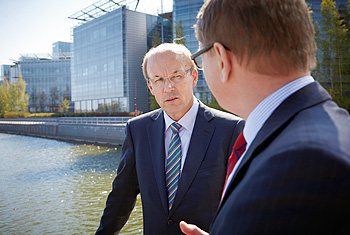
The Focus: Re-prioritizing and identifying new must-win battles, promoting these development programs intensively… The strategy seems to be as much about how you do things as what you do.
Alahuhta: Exactly. And today more than ever. We are very active in getting all our people involved and encouraging everyone at the company to see our business based on customers’ and users’ experiences. This gives us the right perspective in everything we do and shapes how we do it. An additional comment on this ‘how’ aspect is that we are only pleased with our annual development if employee satisfaction, customer satisfaction and our sustainability efforts all develop positively simultaneously with improving financial performance. Then we know we are on solid ground.
The Focus: And to what extent have KONE’s family origins impacted on how you do things?
Alahuhta: We are very long-term oriented. And as I already said, our freedom to think long term and based on megatrends can be partly attributed to company culture and continuity of ownership. But on the other hand, the way I see it, every day we have to have both long-term and short-term orientation. There is no contradiction there. The two go hand-in-hand.
The Focus: Are you never tempted to compromise in the short term and thereby sell out the longer-term goals?
Alahuhta: We don’t compromise between the short term and the long term. Let me give you an example: When the first signs of the downturn became visible in the spring of 2008, we decided to approach the challenging economic situation as an opportunity. Apart from China, the construction market weakened worldwide, with the New Equipment elevator and escalator market especially weak in Europe and the United States.
So we decided to focus our efforts especially on those market segments that would offer more opportunities even during a recession. Geographically, we took action to strengthen our market position in Asia. Regarding vertical segments, we decided to focus on the infrastructure market, which we believed would be an area for stimulus packages. At the same time we decided to develop activities in our services business even more strongly, as this typically brings stability in difficult market phases. And we accelerated our five development programs. However, what is most important is that we decided to invest even more in people development. Our thinking was that this would help all of us to maintain a positive mindset, even in a situation where we read and heard bad news from the media every day.
In this way we built a win/win approach for our people and our company and managed the difficult short-term phase in a way that supported our long-term development. As a result, we managed to improve our financial performance during the recession.
The Focus: One traditional contrast between family-owned businesses and public corporations is that family firms tend to be more conservative, while public companies are more willing to embrace risk…
Alahuhta: Like with long- versus short-term thinking I don’t see these as opposing alternatives. I think we can and must do both. KONE’s culture historically is that we are ready to take a risk whenever an opportunity presents itself. Maybe, compared to many other family-controlled companies, KONE is different in this respect.
“The more you develop a company and the more you achieve, the more you see what there is still to accomplish.”
The Focus: Thinking about the overall issue of growth, how would you describe the KONE view? Family-owned businesses are generally seen as having a strategic leaning towards adaptation, while public companies are more compelled to pursue constant growth.
Alahuhta: Through our development programs we have become more growth-oriented. At the same time the company culture has definitely been supportive of longer-term thinking, giving us a strength that non-family controlled companies may not necessarily always have. From my perspective as CEO, having a chairman who represents the family and is the key owner of the company is a strong-point that makes it easier for me to do a good job. I know – and the team knows – that we have his and the Board’s full support. The relationship simply works well.
The Focus: How are KONE’s performance culture, history and character reflected in the way you develop your people at the company?
Alahuhta: In people development we pay a lot of attention to developing leadership capabilities. In people leadership programs the key aspect is to make the programs as relevant as possible. In middle and top management seminars between 2005 and 2007 the topic was “change management”. During the years of recession, the topic was “leading in difficult times”. Now we are working on how to get back to stronger growth in an uncertain environment.
Our biggest effort, however, has been focused on giving extensive leadership training to more than 3,500 team leaders. Many of these leaders are heads of our well over 1,000 offices on different continents. Their team members – maintenance and installation technicians and sales people – work with our customers all the time. Hence, their leadership skills have a major impact on how satisfied our customers are.
The Focus: When you set out to recruit and retain new talent, what do you look for? How do you attract top talent to KONE?
Alahuhta: We look for people of high integrity with a passion to achieve and a high energy level they can employ to energize others. We pay attention to what kind of company a person has been working for. And in that respect we do not recruit from the obvious choices. It’s been our practice instead to recruit from the leading companies in fast-moving global industries. Hence we know those people have learned in a natural way how to combine local and global perspectives. Attracting top talent contributes to continuous renewal and to our ability to set ambitious levels of performance.
Most important of all is that there is a good fit between the personality of the individual and the culture of the company as a whole. People should feel at home in the work environment, so that it becomes easy for them to invest more energy in the company.
“The more you develop a company and the more you achieve, the more you see what there is still to accomplish.”
The Focus: Going forward from here, are there core values of KONE that are set in stone and never to be changed, or will there have to be some changes to get your organization fit for the future?
Alahuhta: First of all, the more you develop a company and the more you achieve, the more you see what there is still to accomplish. In the morning when I come to the office, I feel more reasons and more opportunities to develop the company than I felt in 2005. And I don’t think this feeling is unique to me. When, as a team, you look deeper and deeper into customer needs, you see more things that you would like to improve or change. The deeper you go, the more granular the ways of managing and developing the business become. It’s a never-ending job.
I think we have built a solid foundation to face what lies ahead. Operational excellence comes from excellent processes, certainly. But during the last six and a half years, we have learned that beyond this rather generic value creation, it is even more important to invest in developing excellent, motivated people.
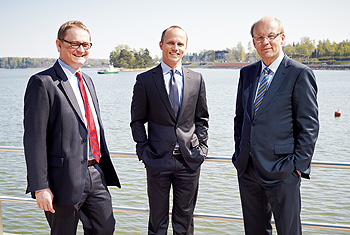
The interview with Matti Alahuhta in Espoo was conducted by Olli Laurén, Egon Zehnder, Calgary and Helsinki (left) and Petter Eilertsen, Egon Zehnder, Copenhagen.
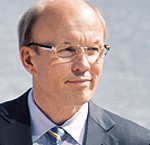
Matti Alahuhta
Matti Alahuhta has served as President of the KONE Corporation since January 2005, becoming President and CEO in 2006. He has been a member of the Board of Directors since 2003. Mr. Alahuhta came to KONE after a 26-year career at Nokia. He was a member of Nokia’s Executive Board for 12 years. After guiding KONE through the most stressful period of the global economic downturn – while managing to advance the company’s growth agenda – Matti Alahuhta was presented with the “European Manager of the Year 2009 Award” by the European Business Press. He continues to drive the company’s overall growth efforts through a series of carefully structured change programs that engage and motivate people throughout the organization.
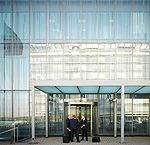
KONE Corporation
KONE Corporation is a global leader in providing innovative solutions to move people smoothly and safely in an increasingly urbanized world. The company’s industry-leading escalators and elevators, as well as its automatic building doors, are designed for comfort, safety, and strong visual appeal, with a focus on energy efficiency. Between 2004 and 2010, KONE’s New Equipment market share rose from 9 to 14 percent and operating income from 8 to 14 percent. Headquartered in Helsinki, Finland, KONE has approximately 34,000 employees and a global presence. It has seven production units across the globe and seven R&D centers. The company is listed on the NASDAQ OMX Helsinki Ltd, and had annual net sales last year of EUR 4.987 billion.
PHOTOS: RÜDIGER NEHMZOW





